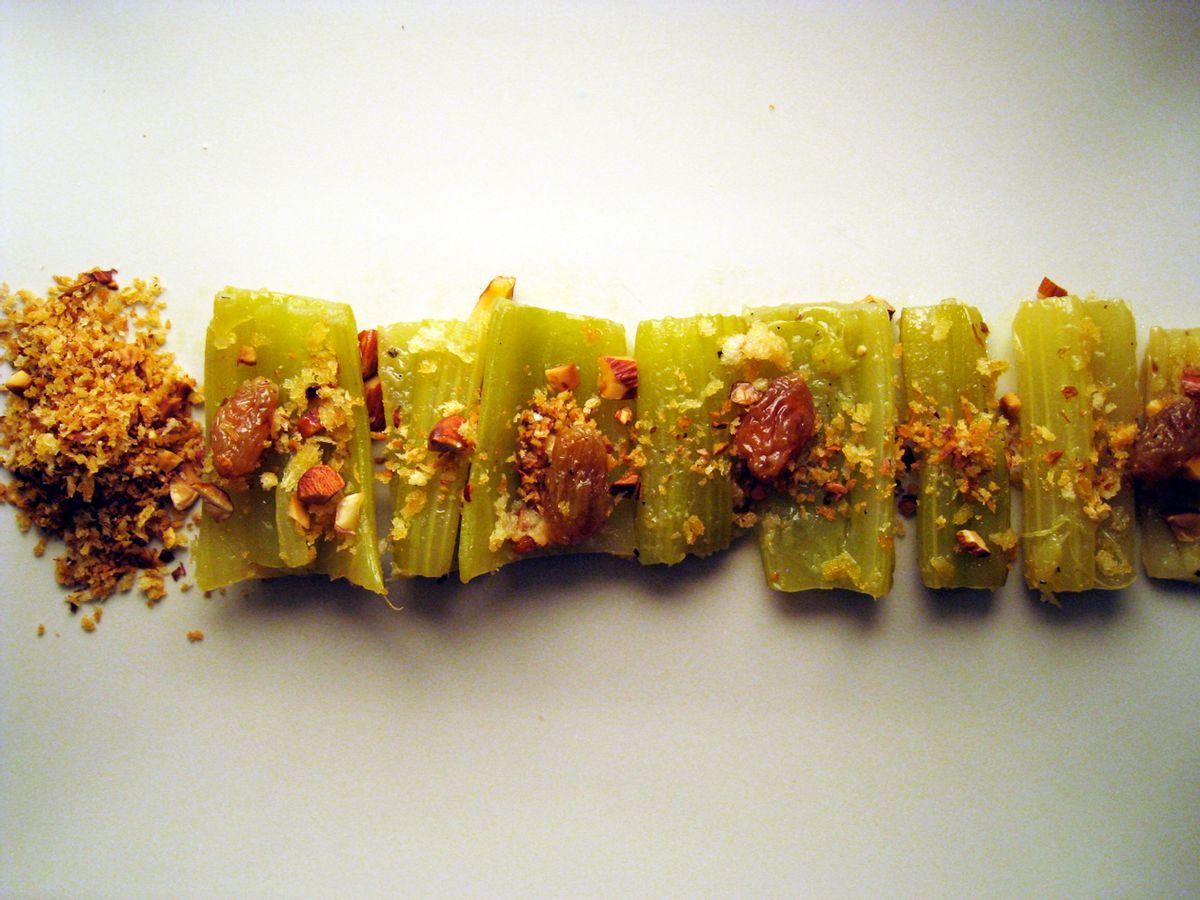Pity celery. Who respects it? For most of us, celery barely counts as food; it’s an excuse for eating ranch dressing, sticks splayed around a bowl of the good stuff. We cover it in peanut butter and stud it with raisins to amuse our children when we really just want their mouths stuck shut.
And every year, right around this time, we buy a bunch of it to chop one lonely stalk for our Thanksgiving stuffing, and soon we look for kids to shut up with the rest.
But celery deserves dignity, modest as it is. Its texture and flavor can be fascinating, turning from crisp and brash to smooth and mellow if you just pay it a little attention. Here are two ways to help introduce you to some of celery’s lesser-known pleasures.
Hot Buttered Celery
Serves four to six as a side
This takes ranch dressing’s water slide and turns that relationship inside out a little, softening the textures and marrying, rather than contrasting, celery’s floral, vegetal flavors with rich fat.
1 bunch celery
1 tablespoon stock (chicken, vegetable, whatever floats your boat) or water
2 tablespoons butter, cut into four pieces, chilled
Salt and pepper, to taste
Parmesan cheese, to taste
- Set a big pot of water to boil over high heat, and salt it. How much salt? Too little and the water will taste flat and metallic, and too much will make it taste painful. So somewhere in between.
- Cut off the bottom from the bunch of celery, right about where the stalks start to narrow, and then strip the leaves. If you want the final dish to look uniform and pretty, go ahead and take those spindly stalks off the top, too.
- Using your peeler, strip the stalks from top to bottom. Take a look at those long, stringy fibers. They’re kind of beautiful, aren’t they? Coils of green curls. But they’re also 75 percent of why people don’t take celery seriously. I mean, who wants to eat a mouthful of dental floss? So be ruthless; if you have to, go over it twice with the peeler to get all the fibers, and don’t forget to turn it over and go down the edge, too. (But you don’t have to waste the trim. Save it to add to stock or soup for flavor.) You could do it like this dude. Check out the tunes!
- Now cut the celery stalks into ¼-inch thick slices. If you’re fancy, do it diagonally on the bias, making elongated U-shapes.
- Is your water at full boil? OK, drop your celery in. After 2 or 3 minutes, taste a piece. When it’s tender and slippery but with just a touch of snap left in its heart, drain it thoroughly, shaking the colander to get the excess water off.
- In a separate pan, or back in the empty blanching pot, heat the stock or water over medium-low heat until some steam comes off. Now here’s a funny little technique: Tilt the pan so that all the liquid creates a puddle where the side and bottom of the pan meet. With a small whisk or a fork, quickly whisk in the butter, one chunk at a time. The butter will melt but emulsify, giving you a thick, creamy-looking sauce. When all the butter is incorporated, add the celery and, off heat, stir to coat it thoroughly. How does it taste? Season with salt and pepper until it tastes good. Shave cheese on top and serve immediately.
Lemon-Braised Celery
Serves four to six as a side
If the peeling and cooking, above, took some of the edge off celery, this recipe really mellows it out. The long, slow stewing pulls a veil over its flavor and melts the stalks into smooth, luscious bites. Whoever thought you could describe celery as smooth and luscious? Well, I just did. But that didn’t stop me from putting some crunch back in with almonds and bread crumbs.
1/2 cup water
2 tablespoons fresh lemon juice (from about ½ to 1 whole lemon; if you need more lemons than that, shame your grocer and buy them somewhere else)
2 tablespoons extra-virgin olive oil
1½ tablespoons honey
1 bunch celery, peeled mercilessly (see above recipe), cut into 2-inch pieces
1/3 cup raisins
1/4 cup chopped, toasted almonds
2 tablespoons toasted bread crumbs
- Find a pot about wide enough for all the celery to fit on the bottom. (Don’t sweat it if it doesn’t; you’ll just have to stir a little more often.) In it, heat the water, lemon juice, oil and honey, stirring until dissolved. Stir in enough salt so that the liquid crosses from sweet to savory.
- Add celery to the pot, and give it a few stirs to coat it with the liquid. Simmer on low or medium-low heat — what you’re looking for is a lazily bubbling liquid. Cover tightly and simmer.
- Give it a stir every 10 minutes or so, making sure it's still bubbling lazily. After 30 minutes, add the raisins. After 40 minutes, take a piece out and taste it. I know it’s not a pretty color. Sorry. But is it smooth and luscious? Maybe a little bit like a potato, a little bit like velvet? If it’s still got too much crunch, just let it keep cooking, up to an hour total. (Add a little water if necessary to keep it simmering.)
- When it is smooth and luscious, uncover it and turn up the heat to evaporate the water, until the juices form something like a glaze. Give it a taste, add a touch of salt if it needs it, and you’re done. Top it with the almonds and bread crumbs right before serving, or let your guests top it themselves to keep it crunchy, and show celery a little love!
Modified from Melissa Roberts’ recipe for Sweet and Sour Celery in the April 2009 issue of Gourmet.

Shares